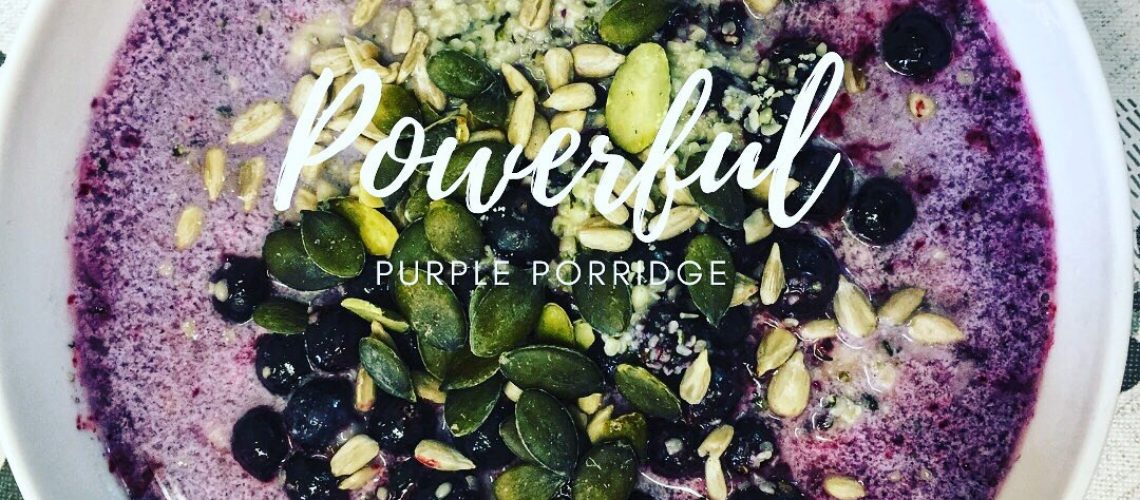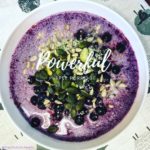
This super nourishingly rich porridge wasn’t planned but was a complete success even by my baby’s standard! I didn’t even realise I had served it up with a purple bowl and plate (no seriously – no staging here!!). I first published this on Instagram in July 2019, and have since made some variations to the recipe.
You could do this hot or cold as overnight oats. It is full of nutrients and goodness and will not have your blood sugar shooting through the roof!.
What do you do for breakfast?
What do you eat in the morning?! Is it the normal bog standard cereal full of hidden sugars or toast and jam, though some of you probably go for porridge with milk and sugar? Or do you skip breakfast altogether? Or are you good at having some protein such as eggs?
Well, change it up by adding a power pack to your morning meal!
This recipe is not only delicious but also provides you with lots of vitamins, minerals and antioxidants you need, as well as the necessary protein, fats and carbohydrates. It will not cause your insulin to spike in order to manage excess sugar, nor will it contribute to imbalancing the rest of your hormones, it will instead gently nourish your hormones and sustain you till lunchtime.
What is wrong with my current breakfast?
The sugar-coated breakfast cereals that you see taking up a whole aisle in the supermarket, are filled with a variety of brands and makes. So much choice for you and your family. It is easy and convenient. It is however full of refined sugar and claims it is low in fat. This is the wrong way round but unfortunately the public are not told this and we are poorly educated, so that we continue to buy these brands and feed our new found sugar additions!!
We don’t want to be having lots of refined sugar at breakfast – if we need something sweet, we want to be having low-glycemic foods and a small amount of natural sugars. It is better to have protein and fats such as eggs and avocado – particularly if you are trying to get pregnant, this is a far better option – but it is not always convenient, I know! If you have Endometriosis, you definitely do not want the cereals, as they contain gluten and many of us cannot tolerate gluten (though we are all bioindividual). Even if gluten does not affect you – these cereals are not nourishing – they contribute to a sub-optimal diet. They are ok for a treat or emergency – but as a regular breakfast we are not doing ourselves any favours.
You need lots of ‘natural’ foods – the more natural the better.
Porridge – not good you say?!
Did you know, if you eat a bowl of porridge with low-fat dairy milk and strawberries it will still cause your blood sugar to spike and then your insulin will need to react accordingly. We all thought that porridge is a good option compared to the sugary cereals! Well it depends how you eat it…..
If you buy the ‘quick’ oats, it has been milled to death, and there is no fibre left. It is a carbohydrate in the form of a simple sugar – not much unlike refined sugar. If you then add low-fat dairy milk, another carb, which is a simple sugar and very little fat, you are loaded up with sugar. If you then go and add strawberries or banana – you are then adding more sugar, all be it natural. So what we thought was a healthy option, is infact not that healthy at all.
I remember finding this out when I was pregnant and I had tested positive for Gestational Diabetes – I was shocked. I had been eating rediculously healthily for about 18 months by this point and thought I knew what I was doing – however my history of a suboptimal diet had affected my body that deeply. I then started researching, and found a fantastic post by Lily Nichols, RDN, CDE on the gestational diabetes and monitoring, including the effects of porridge. I preceded to experiment myself, since then I have made some amazing porridge variations. This is just one of them!
My little baby boy loved this porridge, especially as it was the same colour as his bowl and spoon!!
Why is breakfast so important?
It is so important to eat a good hearty meal first thing that will give you sustained nutrition throughout the morning. This will ensure your blood sugar doesn’t spike and then rapidly drop an hour later, leaving you feeling like you need a sweet snack to keep you going till lunch. Breakfast is what kick starts your metabolism and hormones first thing in the morning. If you eat a poor quality and highly refined sugar breakfast, you are not helping your body. You are increasing your chance of hormonal imbalance, insulin resistance risk and even your risk of diabetes later in life (Ahola et al. 2019). It has also been shown that it does not help with weight loss.
So why is our addiction to sugar and increased levels of insulin a problem?
Well other than the big three concerns of heart disease, obesity and diabetes, it also plays a major role in Polycystic Ovary Syndrome (PCOS), Alzheimer’s, thyroid disease, cortisol dysregulation and other hormone related issues that can affect fertility. Basically, if insulin peaks and dives on a regular basis (like a rollercoaster) in a reaction to our sugar consumption this puts undue strain on our body. Yes it is normal for our body to regulate blood sugar levels, but it is not a process our bodies were designed to do on a daily basis.
“Insulin’s real job is to extract and store excess nutrients so that we can store these for time of famine or need. It was not designed to constantly remove glucose from the blood and store it in fat cells on a daily basis (Nicole Jardim, Fix Your Period).”
If we continue to live our lives like this, our bodies (or rather fat cells) cannot take any more energy being stored and we reach what is known as ‘insulin resistance‘, which if left undiagnosed can lead to ‘diabetes‘.
Most importantly in relation to our sex hormones, insulin stimulates the peripheral muscle to produce estrogen. So if we have high levels of insulin in our body this increases the estrogen in our body. If we are poor at breaking down the estrogen you can get an excess of estrogen (known as estrogen dominance or estrogen / progesterone imbalance), which can then cause painful period pain, PMS, and heavy long periods. Does this sound familiar? Does this sound like there might be a link to Endometriosis also? Does it sound like it might affect your ability to have a good menstrual cycle and conceive?
First make some simple changes
If you do not dare to change your porridge as extremely as the recipe below, here are a few basic tips to ensure you regulate your blood sugar better, so you can help to start balance your hormones:
- Add cinnamon – cinnamon has been proven to help reduce the sugar spike. Add it to anything!
- Use full-fat milk or nut milk – if you are able to tolerate dairy (many women with Endo cannot) – then you should be drinking full-fat organic milk. Sheep or goat milk is better (due to the difference in protein and is more tolerable – this is another post!). Cows are subjected to alot of hormone addition / suppression, antibiotics etc that affect the hormone balance of the milk. If you also then take out the fat, you are further imbalancing the milk, as removing the fat strips away the milks progesterone, leaving the milk to have more estrogen and imbalanced. As women with Endo and wanting to get pregnant this is something we want to avoid!
- Add fat to your porridge – such as coconut oil, nuts, grassfed organic butter – you want to get some fat with your porridge – this is like the cinnamon, it helps prevents the sugar spike, and also helps your body absorb any fat-soluble vitamins.
Why is this porridge recipe so powerful!?
Well, this recipe has protein, carbs, fat, vitamins, minerals and antioxidants and is a great supernourishing start to the day. Buckwheat is a great gluten free alternative to oats, as is quinoa – so until you are ready to eat these on their own, it is a good solution to mix with oats. You could reduce or increase the proportion, just stick with 1 cup per 2 people. Be aware though, buckwheat and quinoa are both high in phytic acid (an anti-nutrient), which means they need to be soaked and rinsed to prevent tummy ache and inflammation.

Here are some great facts:
- Buckwheat is a gluten free pseudocereal (actually a seed) from east Asia that is a slow-releasing carbohydrate with a low glycemic index, it is higher in nourishing vitamins and minerals than rice, wheat and corn and is rich in antioxidants (more than any other cereal) (Bonafaccia et al. (2003), Zdunczyk et al. (2006)).
- Quinoa is a gluten free pseudocereal from South America that is also a slow-releasing carbohydrate. It has lots of protein (one of the few plants that has all 9 amino acids we require), high in fibre and a good source of magnesium amongst many other benefits.
- Nut milk e.g. almonds / cashews (homemade is best) is high in magnesium
- Cinnamon is amazing as preventing blood sugar spikes.
- Hemp provides protein, along with the pumpkin and sunflower seeds.
- Blackcurrants are packed with antioxidants and vitamin C double that in blueberries!
- Coconut oil is anti-inflammatory and provides fat (along with the seeds) to ensure adequate absorption of those fat-soluble vitamins such as A, D, E and K.
- Banana is high in potassium and magnesium – both great for sleep, relaxing muscles and spasms, detoxification and inflammation – particularly great for improving Endometriosis symptoms. It also adds some sweetness (you may want to add a little maple syrup or honey to your taste – but not too much!).
So what are you waiting for! Do try this recipe and let me know how you get on! Did you love it as much as my little boy! Was there anything you didn’t like?
Powerful Purple Porridge
Ingredients
Porridge
- 1/2 cup GF jumbo oats preferably organic
- 1/4 cup buckwheat groats
- 1/4 cup quinoa
- 2 cups water filtered
- 1 /2 tbsp apple cider vinegar
- 3 tbsp chia seeds
- 1 cup non-dairy milk e.g. coconut, cashew, almond, oat
- 2 tsp cinnamon powdered
- 1.5 tbsp hemp powder
- 1 whole banana large & mashed
- 1 cup frozen blackcurrants
- 1 tsp coconut oil organic cold-pressed
Topping
- 1 tbsp pumpkin seeds
- 1 tbsp sunflower seeds
- 1 tsp shelled hemp seeds
Instructions
Overnight Preparation
- Soak the oats, buckwheat groats and quinoa in a large bowl in plenty of water (filtered) and the apple cider vinegar overnight - these will double in size overnight! You are soaking these to get rid of the anti-nutrients.
- Measure out the blackcurrants and leave out to defrost overnight
Making Porridge
- Drain and rinse the oats, buckwheat groats and quinoa.
- Add rinsed grains to a pan with the non-dairy milk and cinnamon.
- Bring the pan to the boil and turn down to simmer for 2-3 minutes.
- Add the chia seeds, blackcurrants, hemp powder, mashed banana and coconut oil to the pan, stir well and heat through for 1-2 minutes.
Serving
- Serve the porridge in a bowl, top with the seeds and enjoy! You may want to add more milk if you like it runnier.
Notes
- Non-Dairy Milk: you can always use dairy milk if you want instead of non-dairy.
- Coconut oil: you can substitute butter instead if you cannot have coconut. You want to have a small amount of fat to help absorb the fat-soluble nutrients.
- Grains: you can use all oats if you do not wish to use buckwheat groats or quinoa - just adjust to have 1 cup in total for 2 people (though this depends if you like alot of porridge or not!).
- Hemp powder: you could use other protein powder, or you could use cacao powder for a chocolatey taste!
- Seeds: you can change these to however you fancy! If you are seed cycling to improve your menstrual cycle, then use those seeds you require. If you are being luxiourious you could toast your seeds - though this does reduce the nutritional power somewhat - though very tasty!






